David Walton
Most organisations want to do more with less. It is important that employees are focused on productive work rather than ‘unproductive work’. I have been involved in a number of cost reduction assignments and many involved looking at what value-added activities staff did as opposed to the non-value added activities.
Having done this analysis it is always surprising to senior management how much time their staff spend on unproductive work.
This type of analysis is not a one-off exercise but should be an on-going one. However, to perform timesheet analysis effectively you need to have a time-sheet system that has the ability to distinguish between productive time and non-productive time. This will enable you to simply run a report on a weekly or a monthly basis to do the analysis.
The goal, of course, is to reduce the level of non-productive time and increase the productive time. A good time-sheet system will allow you to run trend & timesheet analysis reports over time to see how your staff are becoming more productive.
If you are part of an organization that is averse to time-sheet systems, then you need to use sound change management principles to bring staff along with you and get them to accept, and even want to use, time-sheet systems. If the company can improve productivity then this should be beneficial to all.
You need to start, however, with a ‘compelling need to change’. Even if your organisation is doing well it is no good becoming complacent. We all know companies or even industries that have become lazy or even arrogant in how they do things.
They do not constantly strive to be more productive. Sometimes, other competitors arrive who are leaner and more productive and can threaten the existence of the more complacent company.
It is far better to ensure that staff spend their time on ‘productive’ work as opposed to ‘non-productive’ work. Increasing productivity, all other things being equal, should lift company profitability and with the right company ethos all staff should be able to benefit.
The compelling need to change will be different for each company but should include the risk of not being as productive as a competitor.
There are many time-sheet systems out there but not all categorise work into productive or non-productive work. For the goal of reducing waste and becoming more productive, the ability to categorise activities in this way is a key requirement.
The other BIG requirement is that the time-sheet system has to be easy to administer and, even more importantly, easy to complete. There are, of course, many other requirements of a time-sheet system but these two are the ‘biggees’. Too many time-sheet implementations fail because they are too cumbersome to use and not intuitive.

Some timesheet systems also have the ability to assign targets of utilisation and productivity to roles or individual people. As time is recorded the system gives each timesheet user a running total of their percentage productivity. This is a great way of driving up utilizable or productive time.
We all know that there is a lot of time wasted in many organisations. Most people like to be productive at work. They feel that they are doing a more worthwhile job if they are on productive tasks.
They gain self-esteem from this and the organisation can also gain from the increased productivity. It is a really simple tool to employ and it also does not need armies of expensive consultants to do the analysis and recommend improvements in productivity.

Our products help you deliver successful change programmes and projects by always focusing on the overall business outcomes. Find out how our products can help you.
Tell me more Request a demoIt is critical that you take steps to select the right PPM tool as the wrong choice can have a negat...
Read more >We are all familiar with Dashboards and using Red Amber and Green (RAG) statuses to show the ‘heal...
Read more >To implement a PPM system like our PM3 the implementation should be treated like any other project....
Read more >